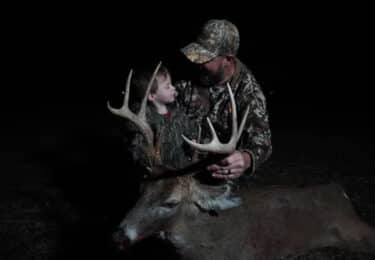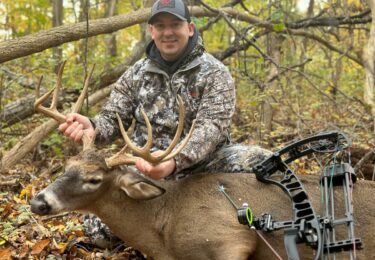Fifteen Tips to Make 2015 Your Best Season Yet
Spring (Part One)
By:
Daniel Watkins
We have finally arrived to that wonderful time of year where waking up, you feel as if the whole world is waking up with you. Apple blossoms and honeydew begin to sweeten the air; wildflowers paint the hillsides. Train whistles are echoed by the thunder of turkey gobbles and fence rows littered with shed antlers. The crappie are spawning, the bass are biting! Isn’t life just serene? To many of us, the vernal equinox is a welcome sign of things to come. We revel in the longer days, warmer air, and the thought of fly fishing a crisp, cool stream. As hunters, we develop a vast appreciation for survival in the earliest stages of our pursuits. We witness firsthand how resilient God’s creatures must be to simply see the sunrise. The winter is bitter, the predators relentless, and the land unforgiving in the season of death and decay. And so, as we mourn the season of harvest, we celebrate the arrival of spring.
It doesn’t matter who you talk to or where they hunt; it is a well-know, understood fact that anyone who has spent any amount of time in the woods has been disappointed and will be again. We’ve all had seasons where we were plagued by bad weather, busy work schedules, or a miss that’ll haunt you day and night. No one wants to think about how much mass the 3 ½ year old 8 point will gain when you’re still sickened by a neighbor’s harvest pictures of the 10 point you’d chased for two years. It’s always easier to be optimistic about the future when things are going your way. Hanging a new set of horns in the living room somehow seems to reaffirm your prowess as an outdoorsman. Often, we mistakenly use only our harvests as a measure of growth or success afield. This is because as humans we tend to favor an achievement over an education. Instant gratification is all but programmed into our blood in today’s society. That being said, our pride tends to take a hit or we lose confidence as the elusive whitetail makes a late season appearance just out of bow range. We can’t help but feel cheated after putting in countless hours at the range or dollars invested in corn kill plots.
Over the past few years, we have seen a rise in first-generation hunters, youth hunters, female hunters, and people with a general curiosity about the outdoors. Other, more seasoned hunters simply don’t put a second thought into the hunting season until the day it opens. At times, the professionals can make it look just that easy; as if they simply set up over a corn field and let nature take its course. If you are a novice hunter who is wondering what you may have done wrong, someone who is looking to take the next step in management, someone who is looking to develop a greater understanding of the game you are pursuing, or just looking for some basic tips, I’ve compiled this article specifically for you.
Shed Hunt
Spring is perhaps the most productive time of the year for a hunter to wear out a pair of boots. Shed hunting is the first and arguably the most important step you can take to properly prepare for the upcoming deer season. Finding a shed antler off of a young stud you saw that had potential or the granddaddy you were chasing can provide piece of mind and anticipation for late summer scouting. It allows you as a hunter to begin cataloging what bucks have survived the winter, the neighbors, predation, and can even help identify the presence of disease. If you are finding a high ratio of dead, mature bucks as opposed to sheds, contact a state conservation office to see if testing for diseases such as EHD or CWD is available.
Sheds can also help to establish which bucks are using your property as a home range and those you got on camera that were just passing through. A shed catalog can help you roughly determine age compilation of your bucks, their nutritional needs, and an overall concentration of deer on the property. Although it may be difficult to establish history with a certain deer or selectively hunt a specific buck, shed hunting is just as beneficial to public land hunters for the reasons listed above. As a public land hunter, this is also a great opportunity to familiarize yourself with new areas of your WMA, thus finding areas with less hunting pressure. More in depth information and shed hunting tips can be found HERE.
Supplement the Herd’s Diet
As we established earlier, the winter months are treacherous on the whitetail population. The bucks spend much of November all the way to January in some areas in full rut, neglecting what little nutrition is available in pursuit of a hot doe. By February, they can drop considerable weight and spend much of the spring recovering on the budding forage, old acorns, and anything else they can find. Shortly afterwards, the bucks begin to shed their antlers and start the process all over again; does begin to give birth to their first fawns in early spring, spending much of their time grazing to nourish themselves through the taxing process of nursing. That being said, the more nutrients available on your property, the more likely you are to hold deer and establish a home range. If you have the time and resources, warm-season food plots act as a catalyst for antler growth and also allow the deer to maintain a sustainable body weight. Many companies offer no-till seed, throw and grow seed, low irrigation seed, round-up ready seed, and high-forage seed to provide a hardy, low maintenance food source for your deer. These varieties make planting nearly effortless and provide those with limited time or resources the best opportunity to grow manageable food plots.
Mineral stations are an important part of the supplementation program as well, providing concentrated quantities of protein, calcium, phosphorus, iron, and other trace minerals found in the antler to facilitate hearty growth. Even if you are unable to plant food plots, proper vitamin and mineral intake is paramount and supplementation is widely practiced. Not only does mineral supplementation help promote growth, but can help reduce the risk for disease and act as an attractant! Establish mineral stations as a sanctuary for the deer, avoiding any unnecessary pressure or presence. Although it is necessary for deer to maintain proper nutrition year-round, mineral supplementation is most noticeably effective through the warmer seasons as antler growth occurs. Check your state and local regulations to ensure that mineral sites are in fact legal, especially in areas where baiting is prohibited.
Invest in the Things You Need
I know I don’t have to convince most of you or even give you an excuse to go to the local outfitter to look around. For some, however, it could be the best decision you make all year. If you’re anything like me, you avoid anywhere with a gun counter or a pro-shop at all costs. This generally isn’t due to a lack of interest or even a need but more often than not it’s the fiscally responsible decision. Hunting and fishing are inarguably expensive hobbies. For that reason, many hunters begin with second-hand equipment or tend to favor the purchase of cheaper gear, understandably cutting corners when possible. No one is saying that the only way to harvest an animal is with a compound made in this decade. There isn’t a state in this country that requires you to wear camouflage or use attractants in the deer stand; I’ve never seen Summit guarantee to buy back anyone’s stand because he didn’t kill a deer.
All disclaimers aside, you aren’t doing yourself any favors using worn, inadequate, or outdated equipment. First and foremost, safety in the outdoors is paramount; cracked limbs or faulty firearms cause tragic, unfortunate casualties each and every year. It could even be argued that not sharpening or replacing worn broad-heads could be considered unethical. Over the past 10-15 years, the outdoor industry has seen an incredible rise in technological advancements. Bows are quieter, lighter, and faster than ever before. Although these aren’t ethical issues, they are features that could give you a slight edge if you’ve ever had a buck jump the string and experienced the heartbreak of missing a chip-shot broadside. Perhaps the greatest blessing of new technology is that it tends to be more forgiving. Case in point; the Ramcat broad-head. I have seen first-hand the absolute carnage this chisel point hybrid will inflict on an animal as it passed completely through the rib-cage of an early season doe in October, hot off of my Darton Scorpion. In the event that it miraculously does not pass through flesh and bone, this unique broad-head will back-cut its way out, making a jagged exit wound to inflict additional damage.
Scent eliminators such as the Xterminator or carbon-based clothing/cover scents give you the freedom to hunt in less-than-favorable wind conditions. This is ideal for the hunters who have limited space or the ability to establish a large number of sets. If your favorite hunting spot is lacking cover, consider investing in a ground blind or utilizing a decoy. The additional cover or distraction may be just what you need to pull him in a little closer or give you just enough time to make that perfect shot. This can also be achieved with the use of feeders or attractants, where legal. Feeders are beneficial due to the ability to keep the attractant dry, away from varmints, and to be delivered on a timed basis to establish a feeding pattern.
One of the most common areas a hunter will neglect in the name of frugality is his comfort. It’s been timelessly proven that the more time you spend in the woods, the higher your chances are to succeed. If you have five hours to sit on a frosty November morning before work but get frozen out in just three, you’ve cut your allotted time nearly in half.
Although it may seem like an unnecessary luxury to spend $250 for a pair of insulated boots or pay the extra $75 for a lock-on with a wider seat, you will thank yourself when the all-day sit pays off. Spreading purchases out through the year also helps to reduce the financial burden in the fall. I can’t identify everyone’s individual need, but it is important for you to sit down and do-so now, to set goals or get acclimated with new equipment long before season arrives. As you grow as a hunter, look past the price tag. If you view a purchase as an investment, you will see the 10-20 years of success you can get out of an item rather than its upfront cost. As you mature, you will begin to realize the long-term value of the confidence reaped from accurate, dependable equipment.
Manage Your Ecosystem
Where I come from, predator “hunting” is just one of those things that just ain’t widely practiced. Now that’s not to say that predators don’t get killed, it’s just normally from a deer stand or a shoot on site basis. Years ago, trapping was widely practiced when the efforts of tanning and selling a pelt actually paid its dividends. Over time, prices began to decline and hunters began to focus their efforts on more seemingly fruitful labors or new species to hunt. Though coyotes never seemed to be a real problem when I was growing up, they seem to have increased their numbers exponentially over the last decade. As a teenager, I can count on one hand the times I actually saw a dirty dog in the woods; now let’s fast-forward a bit. As I think about the last season and last few years, I can count on one hand the number of times I went into the woods and DIDN’T encounter one of those dirty dogs. Late last spring, I found the shoulder of a fawn that had been mutilated; this fall, I found what was left of a nice 8 point laying just steps away from an active coyote den. At my home property, we’ve noticed a drastic decline in total deer sightings over the past two years.
The state of Arkansas as a whole seems to be in a sharp decline in its turkey population over the last decade. Areas where people use to turkey hunt with high success rates over the last few years have seemingly been voided of the Eastern populations that formerly called our hills home. Everyone use to know at least one person who ran rabbit dogs, had a coon hound, or squirrel hunted like it was a religious tradition. Anyone who has hunted for an extended period of time or researched the outdoors has by now begun to establish a pattern. The rise in available food sources, i.e. small game, has helped facilitate the rise of predators. Bobcats, coyotes, bear, wolves, mountain lions, or whatever apex predator rules your neck of the woods have began to thrive due to a lack of competition for food sources. Raccoons are notorious thieves and will rob your turkey nests blind and even compete with whitetail for some food sources. Coyotes are well documented reapers of the fawn crop, wiping out over three-quarters of the population in heavily-concentrated areas.
It is never too late to begin managing your property’s wildlife to create balance, but once you begin you will undoubtedly wish you had done so sooner. If you do not have the time or desire to do so, allow a neighbor, friend, relative, or young outdoorsman the opportunity to do so for you. Predator/small game management is a wonderful segue into the outdoors for someone who is inexperience or curious about the opportunity of hunting.
Get Your Chores Done!
There’s an old saying that you should always save the best for last, and I’m holding true to form. This is perhaps the most important and by far the most time sensitive pointer on our list. Time is such a paradox; right now, you are as far away as you’ll ever be from deer season but getting closer by the minute. That being said, get out there and pull your work gloves up over your elbows! Grab a chainsaw and figure out which trees need to be cut, which limbs need trimmed, or where you’re going to put that warm season food plot. Don’t be afraid of pushing the wildlife out of the area, they are just like us; you will forget things you’ve done today by the end of the month, but so will they. If you have been considering utilizing heavy equipment to dig a pond, plant trees, or even contacting state wildlife officials to prescribe a burn, now is the time to do so. A temporary vacation from your farm outside of harvest season will soon be forgotten and ultimately benefit both parties. Improving and cleaning up the habitat will allow opportunities for new wildlife and vegetation to flourish, brining balance to your property. Don’t be afraid to hang, build or transport stands during the spring. This can even be beneficial as it reduces your workload during the late summer months while allowing the wildlife to become accustomed to these new “landmarks”.
There you have it! Five things you can be doing right now to help improve your odds to lay your hands on a whitetail in 2015. Check back in the early summer as we continue the series and help you make the most out of the warmer months. In the meantime, follow us on Facebook, Twitter, YouTube, and Instagram to stay current on the latest content, giveaways, and staff activities!


